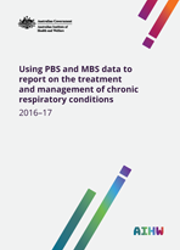Summary
Medication use is the mainstay of management for chronic respiratory conditions, of which chronic obstructive pulmonary disease (COPD) and asthma are 2 of the main conditions, contributing 43% and 29%, respectively, to the total disease burden from all respiratory conditions. Medications are used to minimise symptoms, reduce the risk of exacerbations and improve quality of life. The Pharmaceutical Benefits Scheme (PBS) and Medicare Benefits Schedule (MBS) claims data collected by the Department of Human Services and held by the Department of Health has great potential to provide further insight into how chronic respiratory conditions are treated and managed.
This report investigates the utility of PBS and MBS claims data in answering key research questions for reporting on the treatment and management of chronic respiratory conditions in Australia. It also includes high-level analysis of the dispensing of medications indicated for the treatment of chronic respiratory conditions in 2016–17.
Key findings
Following a review of the literature and consultation with the National Asthma and Other Chronic Respiratory Conditions Monitoring Advisory Group, 15 key research questions were identified as important for monitoring the treatment and management of chronic respiratory conditions in Australia.
Our assessment demonstrated that 10 out of 15 key questions can be answered. These relate to information on medication type; medication name; variation in dispensing patterns by demographic factors; time trends; speciality and prescriber; appropriate or irregular dispensing of medications; consistency with current clinical practice guidelines; uptake of new medications; and the cost of medications (patient contribution and PBS amount).
Five questions cannot be answered. These relate to the frequency of use of medications; adherence to treatment; reason for the prescription; whether PBS data can be used to estimate the prevalence of chronic respiratory conditions; and the rate of development of asthma action plans.
High-level analysis of PBS data shows that in 2016–17:
- over 16.5 million prescriptions were dispensed to more than 3.5 million individuals
- main medication classes dispensed were combination medications (34% of total prescriptions dispensed for respiratory conditions); short-acting bronchodilators and short-acting muscarinic antagonists (SABA and SAMA) (25%); oral corticosteroids (22%); and long-acting bronchodilators and muscarinic antagonists (LABA and LAMA) (12%)
- the supply of medications was generally higher for females and for people aged 65 and over.
A limitation with the data presented in this report is that PBS and MBS claims data on their own do not include information about diagnosis of specific chronic conditions. Therefore, the presence of chronic respiratory conditions must be inferred—which could be achieved by identifying a pattern of use of certain medications in an effort to identify chronic respiratory conditions.
Preliminary material: Acknowledgments; Abbreviations; Symbols
1 Introduction
- Purpose
- About chronic respiratory conditions
- Structure of the report
2 Key questions for monitoring
3 Data sources
- Pharmaceutical Benefits Scheme (PBS) claims data
- Medicare Benefits Schedule (MBS) claims data
4 PBS and MBS data for reporting on the treatment and management of chronic respiratory conditions
- Questions that can be answered
- Questions that cannot be answered
- Questions that could be answered in the foreseeable future
5 Dispensing of medications for chronic respiratory conditions
- Overall medications dispensed
- Medications dispensed, by class of medication
6 Discussion
- Data linkage
- Potential alternative data sources
7 Conclusion
Appendixes:
Appendix A: PBS and MBS data elements
Appendix B: Detailed statistical tables
Appendix C: Chronic respiratory conditions PBS medications
End matter: References



